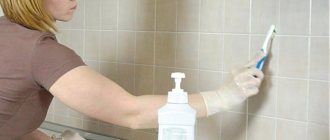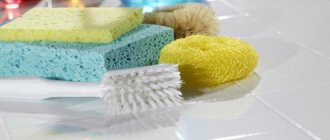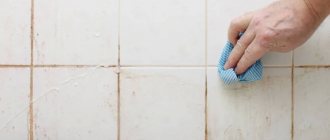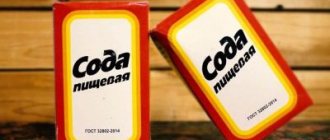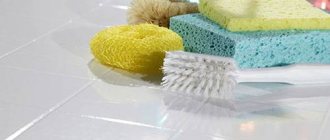Freshly laid ceramic tiles always look neat and pleasing to the eye. Ceramics are a popular, durable and time-tested solution for tiling kitchens, bathrooms and toilets. But over time, the seams lose their presentable appearance and become covered with dirt. And here the housewives are faced with the question: how to clean the seams between the tiles easily and quickly?
There are quite a lot of ways - from folk recipes to professional chemistry and even complete removal of stitches.
The choice of a specific method depends on the condition of the space between the tiles: if it’s just dirt, you can get by with traditional methods, and if there’s mold, it’s better to use household chemicals.
Causes of pollution
Of course, floor tiles get dirty most often and quickly for obvious reasons. But even the seemingly obvious reasons are worth understanding in order to prevent the loss of the presentable appearance of the seams in the future.
Common causes of grout contamination:
- ingress of dust and particles of finishing materials during repairs;
- poor rinsing of seams during cleaning - detergents or simply dirty water may remain;
- ingress of water, which creates an excellent environment for fungal growth;
- natural settling of dust in the toilet or grease in the kitchen;
- irregular cleaning of the premises.
It is worth noting that grout can darken on its own, even if it is cleaned regularly. This happens from old age, for example, if the tiles have not been changed for more than 10 years. In this case, rather than cleaning, it is better to renew the grout.
A radical solution to the problem, or if the mold has penetrated too deeply
Once mold penetrates the structure of a material, it is difficult to completely remove. In these cases, chemical-based products become ineffective. It is recommended to use a more radical mechanical method:
- prepare the scraper;
- to facilitate the process, treat the seams with a vinegar solution;
- the joint space is freed from grout, but the tile adhesive does not need to be touched;
- remove dust and debris from the surface, which will increase adhesion;
- the seams are treated with antifungal agents, and it is important to follow the instructions, otherwise the quality of adhesion of materials will decrease;
- new grout is applied.
What are the dangers of pollution?
Ordinary compressed dust practically cannot harm a person, unless it causes an allergic reaction, cough, or simply an unjustified feeling of beauty.
The real danger is mold, which likes to settle in damp places, which include the bathroom and kitchen.
Mold can cause:
- poisoning of the body;
- diseases of the respiratory system - asthma, pharyngitis, bronchitis, rhinitis;
- dermatitis;
- diseases of the circulatory and nervous system;
- suppression of immune mechanisms.
When mold is first discovered, you must immediately begin to fight it, since its spores may already be on your toothbrush, towel or washcloth.
Cleaners
Even folk recipes can remove dirt and incipient fungus, but professional ones are also often used. The choice of a specific product is influenced by the nature, degree and duration of contamination. May require:
- several rags or sponges;
- a hard old toothbrush;
- pure water;
- detergents;
- Remedies.
But the choice of detergents is quite large.
Household chemicals
Household chemicals have long saved housewives time and effort, making it easier to clean the house. Various manufacturers have come up with a variety of solutions for contaminating the space between tiles. You can find sprays and even special markers.
It is worth taking a closer look at the following brands:
- Melleurd;
- Litonet;
- Unicum;
- Pemolux;
- Silit;
- Cif;
- Amway;
- Domestos.
These are the most effective, but tile-friendly products.
You can also treat dirt in tile joints using the now popular melamine sponge: it works like a pencil eraser, but you must wear gloves, since the product is aggressive and can cause irritation.
But you should be wary of serious substances containing chlorine, especially if the grout is colored and not just white. Chlorine is an aggressive component that can bleach the seam where it is applied.
Typically, household chemicals are used after traditional recipes have been tried, but the desired result has not been achieved, that is, when there is severe contamination.
If it is important to quickly get an instant result, then you can use a special marker that will paint over dirty tile seams, but will not get rid of the dirt.
This solution is suitable for a temporary option when you need to portray the illusion of beauty and purity. Sometimes markers have anti-fungal protective impregnation, which will still benefit the grout a little. This grout care product has several more advantages:
- safe for humans, as it does not contain harmful substances;
- the seams acquire shine and a beautiful appearance;
- the composition of the marker has waterproof properties, that is, mold cannot appear there (but it can spread).
It is also easy to use, but the effect does not last long: a maximum of one year.
Folk recipes
Experienced housewives love to resort to folk recipes because they:
- not so aggressive
- their components are often at hand at home;
- are cheaper.
There are several proven and effective ways to clean the joints between tiles.
Recipe 1. Take one and a half liters of clean warm water and add there:
- one glass of baking soda;
- ¼ cup vinegar 9%;
- 1/3 cup lemon juice;
- 1/3 cup of ammonia.
Mix the resulting solution well, soak a sponge in it and apply to the seams. Rub if necessary.
Recipe 2. The sequence of actions is as follows:
- Take a liter of water and add 100 grams of bleach, mix thoroughly.
- Apply to stains and leave for 10 minutes.
- Afterwards, rinse thoroughly with water and wipe with a dry cloth.
The mixture is quite aggressive, so it is better to work with it in well-ventilated areas.
Recipe 3. Add equal parts to water:
- baking soda;
- mustard;
- citric acid;
- dentifrice;
- ammonia.
Apply the resulting mixture to the tile joints, leave for half an hour, and then rinse off.
Recipe 4. Sometimes it seems that Coca-Cola can replace all household chemicals in the house. Yes, it will also help with problematic seams between tiles. The convenience of this recipe is that you only need one ingredient - actually, Coca-Cola or Pepsi-Cola itself. Soak a rag or sponge in soda and apply it to the seams, leave for 30 minutes, then rinse and dry.
You can use the remaining soda to clean the toilet or descale the kettle - anything is better than drinking it.
Any of the above recipes requires working with gloves, as a chemical burn or allergic reaction may occur. If the mixture does get on the skin, the area must be thoroughly rinsed with running water.
General rules for caring for the space between tiles
In order not to have to think about how to clean the joints between the tiles later, you should take proper care of them from the first day after the repair work. To prevent contamination, you will need to follow simple rules:
- Periodically, at least twice a month, it is necessary to carry out preventive cleaning of the grout.
- After bathing, be sure to wipe the tiles dry and open the bathroom for ventilation.
- Do not use products containing abrasive particles for hygiene measures; they are a source of micro-scratches that attract dirt.
Preparation for procedures
Preparation for cleaning is a very important stage that cannot be skipped, since the result depends on it, among other things. The essence of preparation is to remove unnecessary items from the room and acquire the necessary tools.
- Remove all unnecessary items that may interfere with cleaning - for example, hooks, shelves, bottles of shampoo and other personal care products.
- Remove all textiles, as they can absorb unpleasant odors from cleaning products.
- Assess the need to remove the sink or toilet. Do this if necessary.
- Prepare gloves, safety glasses, a respirator and the grout cleaner itself.
- Wash the tiles themselves and the seams from greasy stains and clean easily removable dirt.
This small instruction will help you check whether everything is done correctly and whether you can begin cleaning activities.
Helpful information
To ensure that the activities carried out give the maximum positive result, experts advise:
- When using any chemicals, be sure to follow the instructions clearly written on the packaging.
You should use personal protective equipment and ventilate the room during and after cleaning. - Before you start treating the entire floor, it is recommended to test the purchased product on a small area in order to avoid adverse consequences such as destruction of the grout and tiles.
- To remove various types of dirt, it is better not to use a universal product, but to remove grease, then soot and limescale one by one. The last thing to do is deal with mold.
- If the cladding is made of glass materials, acidic agents cannot be used to clean the seams. It is necessary to give preference to traditional methods without aggressive components.
Methods for cleaning seams
How to clean them depends on the room where the seams are dirty. For example:
- in the bathroom - there is often high humidity, so mold and mildew form. Their spores are capable of penetrating into the deepest layers, which only professional deep penetration tools can handle. It is imperative to pay attention to the presence of antifungal components in the composition. Folk recipes, and especially ordinary soap, are powerless here;
- in the toilet - the seams in such rooms most often suffer only from particles of dust and dirt, so removing them is quite easy. You can cope with ordinary soap and folk recipes, or resort to household chemicals. In the latter option, it is worth making sure that the composition contains antibacterial components;
- in the kitchen - here, too, high humidity is often maintained, but the main problem is still grease. Splashes from cooking or washing dishes quickly pollute the space between tiles and are quite difficult to clean. Both folk recipes and professional products with a large amount of surfactants that can break down fats are suitable for the kitchen.
Regardless of the room, it is worth remembering to protect your hands and respiratory tract.
Steam cleaning
A household steam cleaner will help restore the walls to their original cleanliness. This is a special device that releases hot steam under pressure. Steam easily removes old stains, kills pathogenic bacteria and even destroys spores of moldy fungi that have penetrated the grout.
For high-quality cleaning, you should give preference only to those devices that can heat up to a temperature of at least +175 degrees.
It’s worth paying attention to the equipment – the brush attachment will come in very handy: the steam will become more concentrated, so the efficiency will increase.
After steam treatment, the seams should be rinsed with ordinary water at room temperature and additionally treated with special antifungal agents. The treatment itself is quite easy: you just need to bring the switched on steam generator closer to the seams between the tiles and move it slowly. If stains remain, they are removed with a rag or an old toothbrush.
Household chemicals
You can eliminate black deposits in the bathroom using household chemicals. Ready-made formulations are easy to use, effective and quite safe.
Chlorine-containing products
Mechanical cleaning of tile joints in the bathroom with a toothbrush.
There are many disinfectant formulations containing active chlorine. These include Komet, Domestos, Beliznu gel. No less effective is chlorine powder, which is mixed with water before application. To clean bathroom tiles, thick compounds are used that penetrate the thickness of the grout and destroy mold.
Before use, study the instructions and prepare skin and respiratory protection.
Processing is done as follows:
- Wet the tiles and tile joints with water. Apply the chemical with a sponge or toothbrush.
- Leave the composition on surfaces for half an hour. This time is enough for the active components to react with contaminants.
- Clean the seams with a brush and rinse off the detergent.
Chlorine-containing household chemicals are used only for the restoration of white grout.
Special pencil
Pencil for bleaching tile joints.
A pencil is a modern means of cleaning the space between tiles. It is easy to use, safe, and effective. The pencil removes dirt and destroys pathogenic microorganisms. The product can be used to clean any tiled premises. All joints are processed with a pencil. The water base allows the composition to penetrate deep into the grout, due to which the surface is cleaned in a few minutes.
Oxygen bleach
An oxygen-based bleaching composition will help whiten old grout and eliminate mold and bacteria. Before use, it is diluted with water in a 1:1 ratio. Using a brush, distribute the bleach over the contaminated areas and leave for 3 hours. Remaining dirt is removed with a sponge, and then the surfaces are washed.
Using oxygen bleach.
Destroy mold and mildew
Removing mold is a complex process that even professional means cannot always cope with. It is important to catch the onset of fungus at the very beginning - then the chance of defeating it is high, but in other cases it may be necessary to completely remove the grout. This is a rather labor-intensive process, for which they usually hire a specialist - with his experienced hands he will do everything correctly, quickly and accurately.
After the grout is removed, it is necessary to carefully treat all seams, gaps and joints with a special antifungal agent. After the space between the tiles has dried, the procedure is repeated. Then apply new grout.
There are several rules that will allow you to do everything right.
- Carefully read the instructions for the cleaning product - sometimes the soaking time on the seams is different and not all products require reapplication.
- The rag with which the surface was treated is burned or thrown away.
- If you have a hair dryer, it is better to use it to dry the seams. Can be replaced with a regular household option. At the time of processing, the room should not be humid.
There are also folk recipes for getting rid of mold in tile joints.
Recipe 1. You will need one liter of water and 10 grams of copper sulfate. The ingredients are mixed and applied to the surface to be treated. It is better to get into the seams with a hard brush or an old toothbrush. If there are a lot of black mold spots, you can repeat the treatment 2-3 times. After drying, the surface is washed with water, dried, and the room is ventilated.
Recipe 2: Requires chlorine bleach. Working with it is much faster than in the previous version, since the exposure time is reduced to several minutes. For such simplicity you will have to pay with a strong odor, so after treatment the room must be ventilated.
There are also industrial products that can help fight mold. There are a great variety of them on the market; you can focus on the following manufacturers:
- Cilit;
- Unicum;
- Savo;
- San Klin;
- Neomid;
- Bugs;
- Ceserit.
All these products contain special substances that have a detrimental effect on fungal and mold spores.
Why clean tile joints?
Ideal cleanliness of the space between tiles is important not only for aesthetic reasons. Dangerous pathogens and mold multiply in hard-to-reach crevices and high humidity. The latter very quickly spreads flying spores and affects the entire apartment.
Aspergillus mycotoxins are dangerous to human and animal health. They can cause chronic allergic and inflammatory reactions, dermatitis, intestinal disorders and even malignant tumors. In addition, mold destroys decorative coatings, furniture and household appliances.
It is very difficult to get rid of fungal colonies in the bathroom without cosmetic repairs. Therefore, timely cleaning is necessary not only to maintain its sanitary condition, but also to extend the life of decorative interior decoration, appliances, sinks, and bathtubs.
Remove other contaminants
There are other contaminants that can be classified.
| Nicotine | If there is a lot of smoking in the room, then over time a yellowish or brownish coating appears on the seams. This problem can be easily solved with the help of acetone, gasoline, white spirit and other organic solvents. If the situation is not advanced, you can get by with vinegar and lemon juice. |
| Rust | Rust on the grout only appears if there are pipes nearby. The best option to get rid of such a scourge would be ordinary household chemicals marked “For rust,” for example, Sanox. Alternatively, you can use a melamine sponge. |
| Old stains | It is best to immediately get rid of old yellowed or cracked grout and make new one. But you can try to revive it with folk or industrial means, or simply paint it over with a special marker. But the result of such cleaning by a renovator will last for a maximum of a year, then you will have to repeat the procedure. But a pencil like this is a great way to briefly refresh and update the appearance of your seams. |
If you regularly clean the joints, the grout will not deteriorate, even if there is a lot of smoking in the room, there is a chimney nearby, or it is simply 10 years old. The main rule in caring for seams is regularity.
It would seem that white seams are the most difficult to clean. This is actually not the case, as any bleach will do the job. But colored grouts cannot afford such a product, as they will significantly lose their brightness. That is why there are usually no difficulties with how to bleach seams. The main thing is to be careful and not step on the tiles.
Briefly about the main thing
Cleaning grout on a tiled surface is a task that everyone has faced. Regardless of the reason for the change in appearance, there are several ways to restore the attractiveness of the grout. The easiest way to do this is to use ready-made household chemicals. Taking into account the level of neglect, the seams are treated with compounds containing surfactants, or more effective chlorine-containing mixtures are chosen.
Radical methods are used if mold is observed in the seams. In other cases, you can get by with proven home recipes that are practical and inexpensive. If desired, you can use an alternative method of cleaning the grout in the form of a steam generator, melamine sponge or marker.
How to remove grout?
If even professional products helped only for a short time, this means that mold and mildew spores have penetrated deeply. To get rid of them, you will have to remove the grout completely. If you don’t want to hire a specialist for this, you can do it mechanically with your own hands. But there is one secret that will make this grout renewal process easier.
If you mix vinegar with water in a 1:1 ratio and apply the resulting solution to the seams, the composition will soften and the grout will be easier to remove.
This is done with the abrasive side of a regular dishwashing sponge. If the tile has a textured surface, then it is better to use the soft side of the sponge so as not to damage the tile.
You can also use cruder tools:
- spatula;
- screwdriver;
- with a knife;
- folded sandpaper;
- chisel.
But they must be used very carefully so as not to damage the tile with the sharp end.
Prevention
Prevention is much easier than correction. That is why it is worth knowing the measures that will help avoid mold on the seams between the tiles.
The main cause of fungus is high humidity, so all measures are aimed at maintaining a normal atmosphere in the room:
- monitor the serviceability of pipes and immediately correct leaks;
- eliminate condensation and find out the reasons for its occurrence;
- dry clothes not in the bathroom, but on the balcony;
- maintain good ventilation;
- if necessary, use a fan with an exhaust function;
- keep the washing machine clean and dry;
- If there is a shower stall, open the doors after use;
- carry out regular cleaning;
- periodically inspect the premises for early detection of mold;
- frequent ventilation.
These steps will help maintain a healthy indoor atmosphere, which will minimize the possibility of mold growth.
General recommendations
Maintaining humidity at the proper level is very important, but there are other steps that will help prevent rapid contamination of tile joints:
- timely care of tiles and cleaning of dirt;
- treatment with special means that prevent mold spores from penetrating into the deep layers of the seams;
- treating tile joints with a special impregnation immediately after applying the grout;
- At the renovation stage, you can abandon small tiles - this will reduce the number of seams that need to be cleaned.
Here a new difficulty may arise with which impregnation is best to choose. There is no need to be original in this matter, but it is best to choose an impregnation of the same brand as the grout: in this case, the products will work in synergy.
Tile features
If every tile could be cleaned with the same grout cleaner, it would be too easy. There are a number of restrictions for each type.
| Glossy and glazed surface | Do not use acids as this will cause tarnishing of the tiles. |
| Matte tiles | It is important to wash it thoroughly after the procedure and then cover it with a special protective mastic. |
| Mosaic and glass tiles | They are quite stable, but do not tolerate highly concentrated agents (both alkaline and acidic) |
And it is forbidden to use highly abrasive materials on any tile, as this will cause microcracks and scratches on the surface, in which bacteria will thrive.
Using paint
Painting is the easiest and fastest way to update tile joints. For work, you can use lime, water-based paint or special coloring compounds.
Staining helps maintain cleanliness for no more than six months (then the process will have to be repeated).
To ensure that the paint lies evenly, the seams are painted according to the following algorithm:
- the surface between the tiles is thoroughly cleaned with sandpaper or a stiff brush;
- paint is applied with a thin brush to dry, prepared surfaces;
- if paint accidentally gets on the tile, it must be wiped off immediately with a soft cloth;
- twenty-four hours after staining, you can evaluate the result of the work;
- if necessary, unfilled areas of tile joints are repainted.
Silicone transparent sealant, which is used to cover already painted seams, will help to maximize the renewal effect of painting.
The video will show you how and with what to paint the seams between the tiles:
